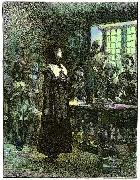|
|
|
|
|
Edwin Austin Abbey
|
|
Anne_Hutchinson_on_Trial
|
|
Anne_Hutchinson_on_Trial,_1901
|
|
|
|
|
|

|
|
Click to Enlarge
|
| Edwin_Austin_Abbey
|
Anne Hutchinson on Trial
new20/Edwin Austin Abbey-539597.jpg
|
|
|
|
|
|
| Anne Hutchinson on Trial, 1901
|
|
|
1852-1911
Edwin Austin Abbey Gallery
Edwin Austin Abbey (April 1, 1852 ?C August 1, 1911) was an American artist, illustrator, and painter. He flourished at the beginning of what is now referred to as the "golden age" of illustration, and is best known for his drawings and paintings of Shakespearean and Victorian subjects. His most famous work, The Quest of the Holy Grail, resides in the Boston Public Library.
Abbey was born in Philadelphia, Pennsylvania in 1852. He studied art at the Pennsylvania Academy of the Fine Arts under Christian Schuessele. Abbey began as an illustrator, producing numerous illustrations and sketches for such magazines as Harper's Weekly and Scribner's Magazine. His illustrations began appearing in Harper's Weekly at an early age: before Abbey was twenty years old. Abbey was an illustrator with Harper's Weekly from 1871-1874. He moved to England in 1878 where he was made a full member of the Royal Academy in 1898. In 1902 he was chosen to paint the coronation of King Edward VII. It was the official painting of the occasion and, hence, resides at Buckingham Palace. In 1907 he declined an offer of knighthood in order to retain his U.S. citizenship. Friendly with other expatriate American artists, he summered at Broadway, Worcestershire, England, where he painted and vacationed alongside John Singer Sargent at the home of Francis Davis Millet.
He completed murals for the Boston Public Library in the 1890s. The frieze for the Library was titled "The Quest for the Holy Grail." It took Abbey eleven years to complete this series of murals in his England studio. In 1908-1909, Abbey painted a number of murals and other artworks for the rotunda of the new Pennsylvania State Capitol in Harrisburg, Pennsylvania. His works in that building include allegorical medallions representing Science, Art, Justice, and Religion in the Capitol Rotunda, large lunette murals underneath the Capitol dome, and a number of works in the House Chamber. Unfortunately, Abbey became ill with cancer in 1911 slowing his work. At the time, he was working on the "Reading of the Declaration of Independence Mural" which was later installed in the House Chamber. Abbey was so ill, that his studio assistant, Ernest Board completed the work with little supervision from Abbey. Later in 1911, Abbey died, leaving his commission for the State Capitol of Pennsylvania unfinished. John Singer Sargent, a friend and neighbor of Abbey, and studio assistant Board completed the "Reading of the Declaration of Independence Mural." Abbey's works were installed in the Rotunda and House Chamber. Two rooms from Abbey's commission were left undone, and the remainder of the commission was given to Violet Oakley. Oakley completed the works from start to finish using her own designs.
Abbey was elected to the National Academy of Design and The American Academy of Arts and Letters. In 1937 Yale University became the home for a sizable collection of Abbey's works, the result of a bequest from Abbey's widow.
|
|
|
|
|
|
|